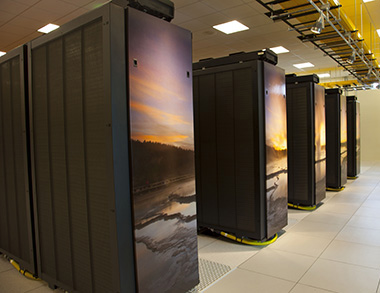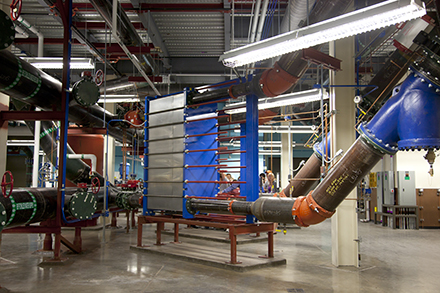NCAR-Wyoming Supercomputing Center opens
First science begins
Oct 15, 2012 - by Staff
Oct 15, 2012 - by Staff
News Release
CHEYENNE—The NCAR-Wyoming Supercomputing Center (NWSC), which houses one of the world’s most powerful supercomputers dedicated to the geosciences, officially opens today.
Scientists at the National Center for Atmospheric Research (NCAR) and universities across the country are launching a series of initial scientific projects on the center’s flagship, a 1.5-petaflop IBM supercomputer known as Yellowstone. These first projects focus on a wide range of Earth science topics, from atmospheric disturbances to subterranean faults, that will eventually help to improve predictions of tornadoes, hurricanes, earthquakes, droughts, and other natural hazards.

A handful of the Yellowstone supercomputer's 100 racks. An iconic scene from its namesake national park is featured mosaic-style on the ends of each rack. The image by Michael Medford, licensed to National Geographic, centers on Fountain Geyser. (©UCAR. Photo by Carlye Calvin. This image is freely available for media & nonprofit use.) View more images in the Multimedia Gallery.
“This center will help transform our understanding of the natural world in ways that offer enormous benefits to society,” says Thomas Bogdan, president of the University Corporation for Atmospheric Research (UCAR), which manages NCAR on behalf of the National Science Foundation (NSF). “Whether it’s better understanding tornadoes and hurricanes, or deciphering the forces that lead to geomagnetic storms, the Yellowstone supercomputer and the NWSC will lead to improved forecasts and better protection for the public and our economy.”
Bogdan took part this morning in a formal opening ceremony with Wyoming Gov. Matt Mead, NSF director Subra Suresh, University of Wyoming (UW) vice president of research relations William Gern, NCAR director Roger Wakimoto, and other political and scientific leaders.
“This is a great day for scientific research, for the University of Wyoming, and for Wyoming,” says Mead. “Wyoming is proud to be part of the collaboration that has brought one of the world’s fastest computers to the state. The center will have a positive impact on our future, through the research done here and by sending the message that Wyoming is honored and equipped to be the home of this amazing facility.”
“The NCAR-Wyoming Supercomputing Center will offer researchers the opportunity to develop, access, and share complex models and data at incredibly powerful speeds,” says Suresh. “This is the latest example of NSF's unique ability to identify challenges early and make sure that the best tools are in place to support the science and engineering research communities.”

Located on the western fringe of Cheyenne, Wyoming, the NCAR-Wyoming Supercomputing Center officially opened on October 15, 2012. (©UCAR. Photo by Carlye Calvin. This image is freely available for media & nonprofit use.) View more images in the Multimedia Gallery.
The NWSC is the result of a broad public-private partnership among NCAR, NSF, UW, the state of Wyoming, Cheyenne LEADS, the Wyoming Business Council, and Cheyenne Light, Fuel & Power. NCAR’s Computational and Information Systems Laboratory (CISL) will operate the NWSC on behalf of NSF and UCAR.
“We are delighted that this successful public-private partnership has delivered a major supercomputing center on time and on budget,” says NCAR director Roger Wakimoto.
Through the NWSC partnership, which will also seek to advance education and outreach, UW will have research use of 20 percent of NWSC’s main computing resource. In turn, UW will provide $1 million each year for 20 years in support of the program. The state of Wyoming also contributed $20 million toward the construction of the center.
“Our access to Yellowstone will allow the university to reach new heights in our educational and research endeavors in engineering; atmospheric, hydrological, and computational sciences; Earth system sciences; and mathematics,” says UW President Tom Buchanan. “The supercomputer is a huge draw for students and faculty. It opens the door to scientific innovation and discovery that will benefit our state, the nation, and the world.”
Located in Cheyenne’s North Range Business Park, near the intersection of I-80 and I-25, the 153,000-square-foot supercomputing center will provide advanced computing services to scientists across the United States. Most researchers will interact with the center remotely, via a laptop or desktop computer and the Internet.
Relative to the most recent ranking of the world’s fastest supercomputers, issued in June, the 1.5 petaflops peak system ranks in the top 20. The rankings constantly change as new and increasingly powerful supercomputers come online.
The main components consist of a massive central file and data storage system, a high performance computational cluster, and a system for visualizing the data.
Scientists will use the new center’s advanced computing resources to understand complex processes in the atmosphere and throughout the Earth system, and to accelerate research into severe weather, geomagnetic storms, climate change, carbon sequestration, aviation safety, wildfires, and other critical geoscience topics.

Some of the NWSC's complex mechanical systems, which were designed with performance, flexibility, and energy efficiency in mind. (©UCAR. Photo by Carlye Calvin. This image is freely available for media & nonprofit use.) View more images in the Multimedia Gallery.
CISL has operated supercomputers at NCAR’s Mesa Laboratory in Boulder since the 1960s, even though the building was not designed with supercomputing in mind. In recent years, new research questions have required more powerful computers to run increasingly complex computer simulations. The Mesa Lab has now reached the limits of its ability to provide the necessary energy and cooling capacity essential for the next generation of supercomputers.
The NWSC is expected to advance scientific discovery for the next several decades. Its design and construction have been "future proofed" by providing the scope to expand as supercomputing technology that does not exist today becomes available in the future.
Raised floors are key to the facility’s flexible design, allowing the computing systems, electrical supply, and cooling to be positioned and controlled for optimal energy use and ease of maintenance. The raised floor is also vented, so air can be circulated as needed to computing systems and servers.
The NWSC was awarded LEED Gold certification for its sustainable design. The center takes full advantage of Cheyenne’s elevation and cool, dry climate by employing ambient air to cool the facility nearly year round. This will significantly reduce the facility's energy use.
A minimum of 10 percent of the power provided to the facility will be wind energy from the nearby Happy Jack Wind Farm. NCAR and UCAR will continue to explore options to increase the percentage of renewable energy provided to the facility in future years.